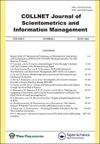Scientific activities, and extent of collaborative efforts in the top academic institutions of India : A scientometric study using Web of Science data
IF 0.8
Q2 INFORMATION SCIENCE & LIBRARY SCIENCE
COLLNET Journal of Scientometrics and Information Management
Pub Date : 2023-01-01
DOI:10.47974/cjsim-2022-0043
引用次数: 0
Abstract
Using more than one lakh publication records from the Web of Science database, we tried to identify the scientific activity (publications, collaborations and citations), sectors of collaboration (University- Industry-Government), & subjects of collaboration in the top 10 NIRF ranked engineering institutes and universities in India. The study indicated that collaboration in different types of academic institutions has steadily increased from 2011 to 2020. Greater growth has been observed in domestic collaboration than foreign collaboration. The international collaboration network tends to be very dense with more advantageous countries. Although, international collaboration resulting in more citations, the fractional impact strength of domestic publications is better than foreign. The impact factor of the journal was observed to be a better predictor than the number of authors per article. University-University sector – mainly different departments of the same institute emerge as the predominant form of domestic collaborative research. While assessing the disciplinary output of the top 10 institutions by establishing a subject framework based on the Frascati Manual and Essential Science Indicator of Clarivate, it was observed that Civil, Mechanical & Electrical Engineering; Chemical, Material & Environmental Engineering; Chemical Sciences, and Theoretical aspects of Physics were the major fields amongst science disciplines with overall 52% of domestic and 48% of foreign collaboration.印度顶级学术机构的科学活动和合作程度:使用Web of Science数据的科学计量学研究
利用来自Web of Science数据库的10多万条出版记录,我们试图确定印度排名前10位的工程学院和大学的科学活动(出版物、合作和引用)、合作部门(大学-工业-政府)和合作主题。研究表明,从2011年到2020年,不同类型学术机构的合作稳步增长。国内合作比国外合作增长更快。国际合作网络趋于密集,优势国家较多。虽然国际合作导致了更多的引用,但国内出版物的分数影响强度优于国外。研究发现,期刊的影响因子比每篇文章的作者数量更能预测结果。大学-大学部门-主要是同一研究所的不同部门-成为国内合作研究的主要形式。在以Frascati手册和Clarivate基本科学指标为基础,建立学科框架,对排名前10位的院校进行学科产出评估时,发现土木、机械与电气工程;化学、材料与环境工程;化学科学和物理理论方面是科学学科中的主要领域,占国内合作的52%,占国外合作的48%。
本文章由计算机程序翻译,如有差异,请以英文原文为准。
求助全文
约1分钟内获得全文
求助全文
来源期刊

COLLNET Journal of Scientometrics and Information Management
INFORMATION SCIENCE & LIBRARY SCIENCE-
自引率
0.00%
发文量
11
 求助内容:
求助内容: 应助结果提醒方式:
应助结果提醒方式:


